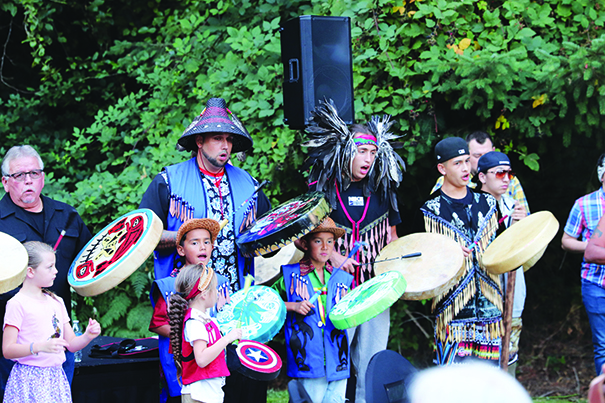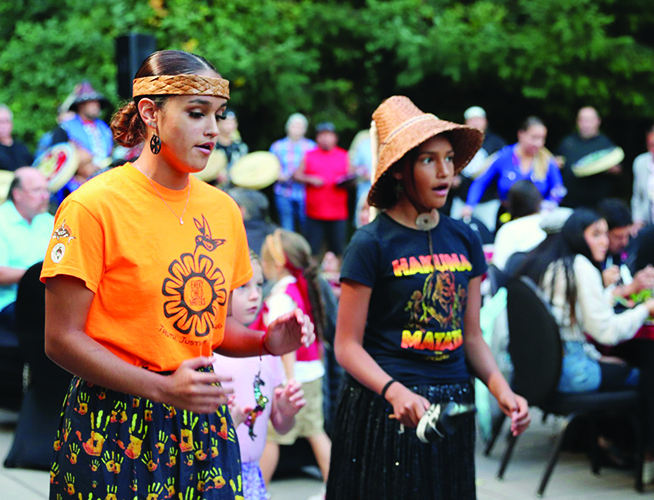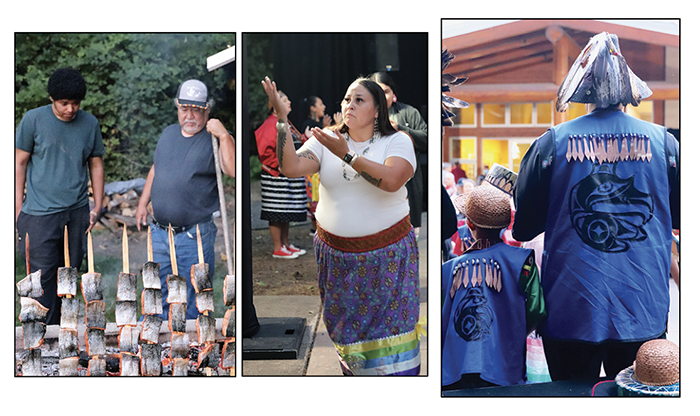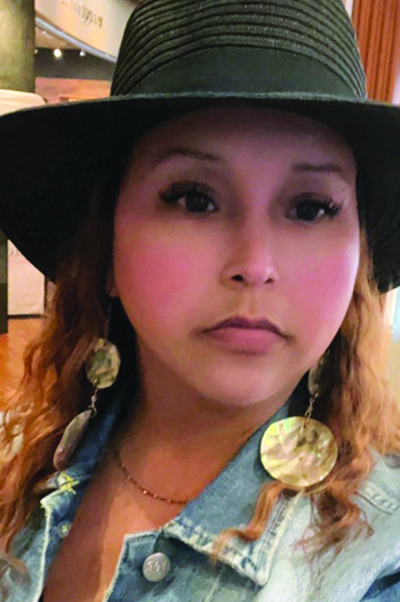Please use the following link to download the October 8, 2022 issue of the syəcəb
Tribal youth are in need of tribal homes
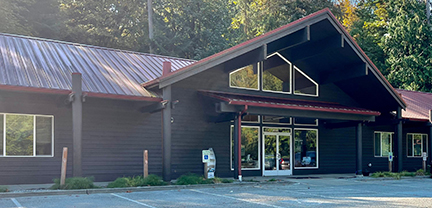
By Shaelyn Smead; photos courtesy of Delia Williams and Theodore Sam
Helping beda?chelh is essential for at-risk tribal youth
The beda?chelh department is in desperate need for respite care workers (daycare) and placement homes (fostering). Unfortunately, with very few tribal volunteers, many of the cases are forced to lean on state-sourced foster resources and non-tribal homes. Leaving a lot of questions and concerns about where these children will end up, and how they will remain connected to the tribe and their culture.
The process for beda?chelh to locate a respite care provider or placement home can be quite grueling. They create a list of family members related to the child and anyone who is 18 years old or over will be contacted and asked if they would be willing to step up and take in their family member.
Tribal member and beda?chelh Placement Specialist Delia Williams who is on the frontlines and helps make these phone calls, said, “Our whole goal is to try and keep our kids here with us. We want to keep families together, but it’s sad because 97% to 98% of the time, these family members will say no. They either aren’t willing or aren’t able to take their family in.” At which point, beda?chelh continues down the list to see if there are any other tribal homes that would be willing to help. After finishing these efforts, and they aren’t able to place into a tribal home, that is where beda?chelh is cornered and forced to utilize State-sourced foster homes.
The reality of having laws like the Indian Child Welfare Act of 1978 and the 1989 Centennial Accord, can be a double-edged sword. The laws have allowed for tribes to maintain jurisdiction over at-risk tribal youth and their wellbeing. Creating a separation between state programs like Child Protective Service and the beda?chelh department. However, it is also up to its tribal members to support the system that is in place and provide services that would otherwise be available through the state. In other words, if there are no tribal respite care workers or tribal placement homes available, then the department is forced to outsource to State and non-tribal workers and homes. At which point, a tribal child could end up living anywhere within the state of Washington, and could be hundreds of miles away from their people.
Why are tribal members skeptical of beda?chelh?
To some, it might seem like simple math. If tribal members want to keep their youth close to their community, they must be willing to open their homes and support their lost cousins, nieces, nephews, etc. So why is beda?chelh struggling to find tribal volunteers?
For some tribal members, it’s the concern that they would be opening up their home to futures investigations and the threat they might have their own kids taken. For others, it’s the risk of behavioral issues that at-risk youth could bring into their home could have an effect on their other kids. Some families feel as though they might not be able to financially afford the costs that come with taking in another child. And for some, it’s simply living in a small community and knowing the backlash they might be facing from their peers.
How is beda?chelh tackling these concerns?
Delia talked about how the department handles some of these concerns. “In any case where a volunteer has a child in their home and in their care, we do a background check, and run a home study to make sure the home is safe, clean, and able to take care of a child. In other cases, where the volunteer just babysits in the family’s home, it doesn’t require a home study. Still, the background checks only go back as far as six years, this allows for tribal members that only have mild records, the opportunity to still volunteer and help,” she said.
When discussing the extrinsic nature of the volunteer respite care or placement position, Delia illustrated that visits from the beda?chelh social worker are only about once a month, just to ensure the well-being of the tribal child. Other than that, the social worker is also helping remind the volunteer of upcoming cultural events that the tribal child can attend, to observe cultural practices, providing sport and extracurricular opportunities, and resources that the child may want/need. These visits are also an opportunity to check on the mental and emotional state of the volunteers in making sure that they are doing okay with their transition. The social worker will then provide the volunteers with any assistance they may be needing as well. If there is a point in which the volunteer feels overwhelmed, they also reserve the right to forfeit their services.
Some families fear that by opening up their home, they risk beda?chelh potentially taking their own kids away from them. Delia spoke that a situation like this would only occur in severe cases that required it. Even then, in her experience she has not witnessed this happen.
Delia said, “If we notice a respite care worker, or placement home provider struggling in any way, we want to help. We know the sacrifices that these people are making, and we want to help our tribal youth as much as possible. Whether we’re helping guide them to programs, or grants, our goal is to help these providers, not hurt them. By helping them, we are helping our tribal kids.”
There is compensation available for respite care workers and/or placement homes. Once a home study and background check has been conducted, and care services have been designated, then compensation will become obtainable. Respite care and family grant amounts vary applicant to applicant.
Money aside, there is still the fear of backlash that a respite care worker or placement home fears. Beda?chelh does ensure confidentiality with every case, however with the coming of social media and living in such a small community, sometimes being anonymous on paper, doesn’t help the reality of the world. Word travels fast and sometimes your services become public knowledge.
One thing that Delia said in regards to this was, “Ultimately these families that are helping only have to tell people what they feel comfortable with. There’s not much we can control when word starts spreading, but I encourage our volunteers to feel comfortable enough to just own it. They’re doing something great for our community and not a lot of people would be willing to do what they’re doing. Every time someone steps up to help a tribal child, it sows that seed that our community is willing to help each other.”
This same backlash is unfortunately what employees within the department face, and Delia deems the reason as to why is there aren’t as many tribal employees working for the department as there should be. “Our people are just as scared and intimidated sometimes by the retaliation we face,” she said. “But we know what is going on with these cases, and we support the decisions that our tribal and non-tribal coworkers make.”
Families that have gone through beda?chelh intake
Unfortunately the beda?chelh department also simply doesn’t have a great relationship with many tribal members and there is a level of distrust. Those families sometimes even speak very publicly about their difficult experience, which in turn carries out a negative perception of the department.
One person who has posted on social media frequently about their experience and has shared her story is Skyla Henry. In 2015, Skyla and her husband struggled with addiction and separated from one another. Skyla’s mother realized all that was going on and took in their kids and raised them for some time. Skyla’s addiction grew deeper and resulted in her being put into prison. During which, life became too difficult for Skyla’s mother, and the kids ended up in beda?chelh’s care, and placed into a home. Years went by as the parents struggled with their sobriety, and the case subsequently closed. Skyla’s husband is now two years sober, and Skyla is four months sober. Now with the two being back together, sober, in a home and working, the couple is anxious and wondering what possibilities there are to be back in their children’s lives. With the case being closed three years ago, it leaves a lot of questions for them.
“I’m really upset because I want some answers,” said Skyla. “I know I haven’t been in my kids’ lives for a long time, and I appreciate all that the placement family has done for them, but you can’t fight the bond between parents and their kids. I just want to know what options I have and what possibility there is for us to be in their lives, even if it’s just visitation. It’s the emptiest feeling in the world being so close to my kids, knowing I could run into them anywhere but not being able to see or talk to them.”
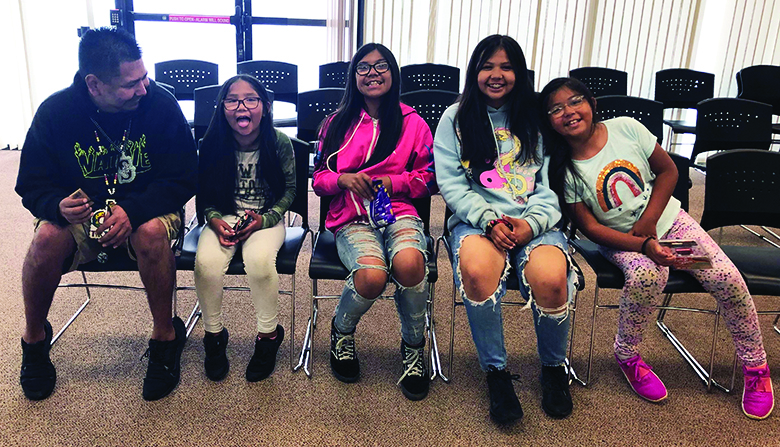
Another tribal family shared a similar story. Theodore Sam struggled with addiction. His four kids were not living in a stable home, and were missing frequent amounts of school. When Theodore first encountered beda?chelh, they were at the beginning of their investigation. “They were coming by and offering different treatment plans and services and were trying to help us. Beda?chelh wanted us to get better, but I didn’t want to receive help,” Theodore said.
Unfortunately, after spending time with the children’s mother, and the parents still struggling with their addiction, the case was taken to Tribal Court and the children were placed into placement homes. At this point, Family Wellness Court provided resources that Family Services has and a case manager stepped in with IOP support, helping Theodore find a home, and create goals and a game plan to get his kids back. Theodore was able to keep contact with his children during that time, but he knew that he needed to do more.
After some time, hard work and dedication, Theodore was doing three Urine Analysis (UA) tests a week, found a job, and a shelter to live in. In March 2022, Theodore earned custody of all four kids. “Beda?chelh has been really helpful, and my case manager even has helped me with picking up my kids, or taking to them to appointments or the doctors. I know beda?chelh receives a lot of hate, but parents need to be able to do the work. It takes time, and you have to do the right things to get your kids back,” Theodore explained.
Delia, who not only is a tribal member and works for beda?chelh, also was once a child in the system. She ended up living most of her life with some of her family in Spokane, away from the reservation. And even though she remained in a tribal home, she was able to witness and give a unique perspective to both sides of the system. She spoke about her experiences with the community turning a blind eye to the levels of addiction, physical and sexual abuse that are prevalent in the community and how it affects tribal families.
“I think it stems from generational trauma and the effects of our elders’ experience in residential boarding schools,” she said. “We hear the stories of the physical, mental, spiritual and sexual abuse that our ancestors and elders went through. The trauma that they endured made it so they couldn’t speak on it, and it has caused and taught our people to be quiet and not speak about what happens behind closed doors. But we have to change that.”
Now is the time to get involved
Currently the ICWA is at risk within the US Supreme Court, and is set to be reviewed in the fall. If the ICWA is overturned, that means many tribes across the nation will struggle to maintain oversight of their at-risk tribal youth. The state in which they live will then oversee the investigation and put tribal children into their state foster care system, and the child risks no longer having ties with their people. Luckily for tribes within the state of Washington, the Washington Supreme Court came to a unanimous decision in 2020 that require the courts to use active efforts to recognize when a child is belonging to a tribe and prevent the breakup of an Indian family. Since then, an official ‘opinion’ in July 2022 was presented by the Washington Supreme Court supporting those same 2020 decisions and the works of the Washington Indian Child Welfare Act (WICWA). Making issues of tribal welfare organizations less at risk in the state of Washington. However, it doesn’t take away the need for respite care workers and placement homes with Tulalip Tribes. Tulalip youth need their community to lean on.
“We need Tulalip’s influencers and leadership to step up and speak out about these issues that we’re facing. It needs to be talked about”, Delia said.
If you or anyone you know is interesting in helping with respite care or are willing to provide placement home services, please contact beda?chelh at 360-716-3284.
Truth, Justice, Healing
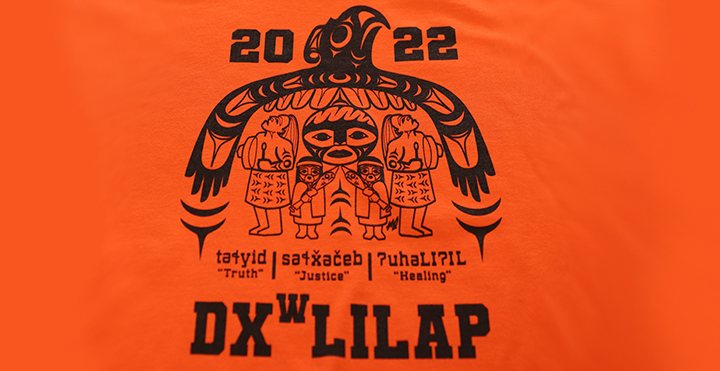
By Kalvin Valdillez, Tulalip News
In anticipation of their second annual community gathering to recognize Residential Boarding School Awareness Day, the Tulalip Education Division once again planned to hand out orange t-shirts on September 30th.
Last year, the Education Division reached out to Tulalip artist, Marysa Sylvester for the very first t-shirt design, which featured a hummingbird and a flower in traditional formline. Keeping true to their theme of supporting and promoting Tulalip artists, the Education Division commissioned this year’s design from Ty Juvinel.
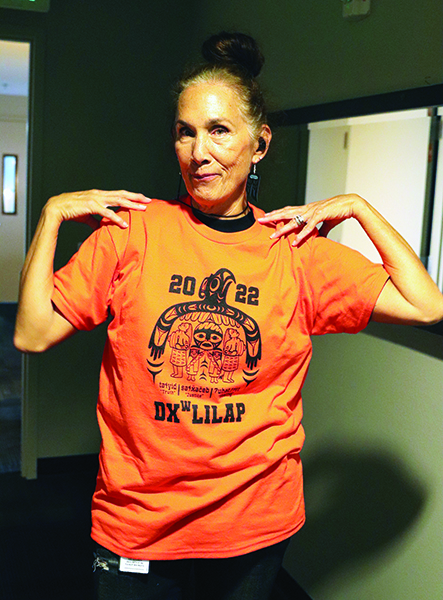
Leading up to the gathering, the design was kept under wraps and was set to be unveiled the day of the event. Hours prior to the ceremony, Tulalip News got an exclusive sneak peek at the design, which displayed the words truth, justice, healing in the traditional Lushootseed language. The design was leaked on the Tulalip News Facebook page and received a lot of heartfelt reactions and comments, and hopefully prompted many to take part in the annual gathering.
Said Ty, “The design represents a thunderbird and the creator watching over the community, with two warrior drummers watching over the children, and the children have their dance paddles showing they still have their heritage.”
Hundreds of t-shirts were handed out at the start of the ceremony, and together as a community, the people brought some truth, justice, and healing through traditional song and dance while proudly donning Ty’s design.
Truth and Reconciliation Day pop-up exhibit at Hibulb
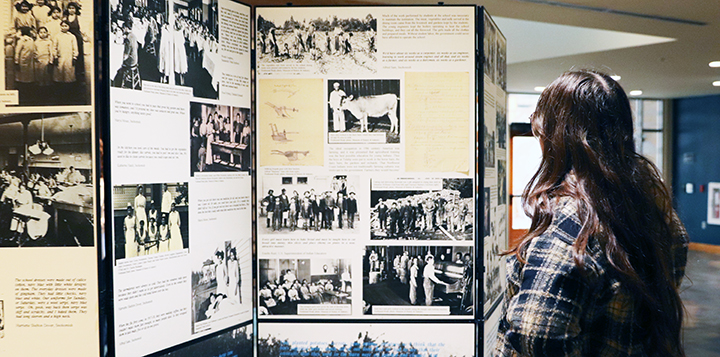
By Kalvin Valdillez
In recognition of Residential Boarding School Awareness Day, the Hibulb Cultural Center held a pop-up exhibit on Friday September 30 to help their visitors gain an understanding about the Indian Boarding Schools. The exhibit gave insight to what occurred at the terrible institutes of assimilation from the point of view of the Indigenous children who attended the Tulalip boarding school.
A heart-wrenching and tear-jerking screening of ‘The Faces of the Tulalip Boarding School’ played on a loop throughout the day inside the cultural center’s longhouse. The HCC giftshop also had a handful of orange t-shirts available for purchase in honor of the day of awareness. And a large double-sided panel was stationed at the center of the museum, which depicted black and white photos of the Tulalip boarding school and its students. Through letters sent home and a number of recorded interviews, the Hibulb Cultural Center compiled several testimonies from the Tulalip boarding school students, which painfully details what they experienced at the school.
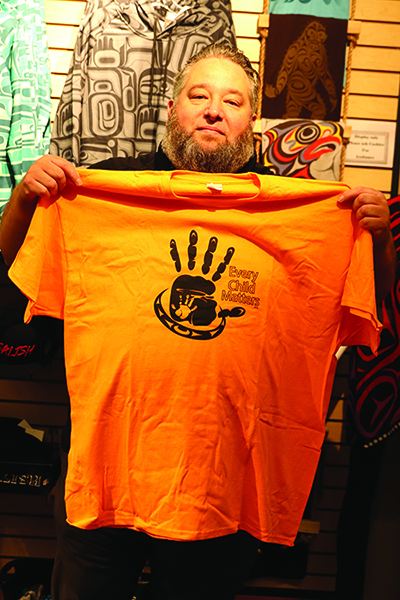
Those dreadful recountings are positioned throughout the panel as captions to various photos. Below are some of those statements.
“The first night away from home seemed like a long, long night. At home, my mother would always go to the bedroom with me and lift me up. Sometimes my father would come to the door and tell me that I was a good girl. At school everyone put themselves to bed. The dormitories were always so cold. They had the windows wide open because they didn’t want us to get tuberculosis. Even in the winter they were wide open, and the cold wind blows over the bay.”
– Harriette Shelton-Dover, Snohomish
“I remember one of those majors, when there was an infraction of the rules, made the girls who went outside the boundaries line up and march in front of everyone in all three companies and get the back of their legs slapped with a ruler. And those girls couldn’t walk. It put scars on them.”
– Vi Hilbert, Upper Skagit
“At Tulalip you had to wear uniforms. They had a celluloid collar. I have a short neck and that thing would stick into my neck, so I’d always have to hold my head way up.”
– Ronomous ‘Toddy’ Lear, Lummi
“It was always meat and potatoes and ugly gravy. One doctor came along, and he changed things. He seen that a lot of us were getting sores around the neck, and he thought it was the diet.”
– Marya Moses, Snohomish
“We had to march from our rooms to the kitchen to eat and back again to get ready for school. And we’d march to the school building. Everywhere we went we’d march, march, march.”
– Ham Green, Makah
“I went to Tulalip. I was six years old. Mother didn’t like it very well, but she said it just had to be done. I felt bad when we was going., heck, along come a boat, a big motorboat, and picked us up. Like little cows, we got in and away we went. We didn’t even know where Tulalip was.”
– Woody Loughtey, Suquamish
“When the flu first came in 1917-1918m they were making coffins, but they couldn’t make them fast enough, so many people died. So, they wrapped them in tule mats, five or six in one grave.”
– Alfred Sam, Snohomish
The cultural center’s pop-up exhibit was a great introductory for those who wished to learn more about the boarding school era. Upon sharing the news about the exhibit on social media, many people who live out of the vicinity of Tulalip requested another pop-up so they can plan a visit in the near future. Several of those individuals expressed that they actually had relatives who attended the Tulalip boarding school and inquired how they could receive additional information and/or photos of their loved ones.
The Hibulb Cultural Center is open Tuesday – Friday 10:00 a.m. to 5:00 p.m. and Saturday – Sunday Noon to 5:00 p.m. For more information, including their exhibits and events, please visit their website www.HibulbCulturalCenter.org or contact (360) 716-2600.
Every child matters
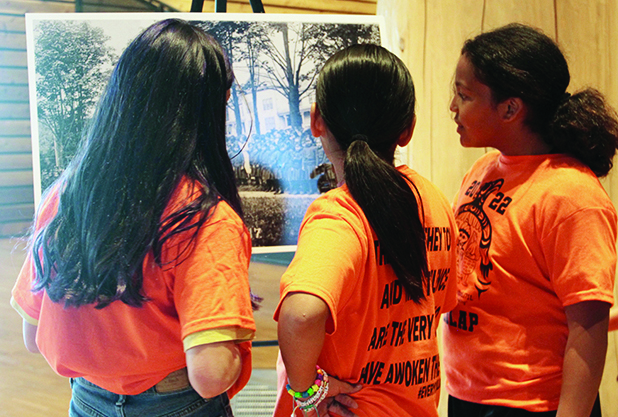
By Shaelyn Smead, Tulalip News
The Tulalip Education Division hosted their second annual Residential Boarding School Awareness Day. The evening commemorated the lost lives from residential boarding schools, and acknowledged the pain that the survivors carry with them every day. Some of the survivors shared their stories, family members spoke about the generational trauma that came from this era, and tribal leaders expressed how our community can move forward together.
Board of Directors Secretary, Debra Posey, spoke about how her grandmother was the first woman ever on the Tulalip tribal council in 1936. Long ago, they would pull their money together for gas, travel and to write letters to Washington DC, urging politicians and legislators to help our people. She spoke about how that same spirit and unity still lives in our people today through events like Residential Boarding School Awareness Day.
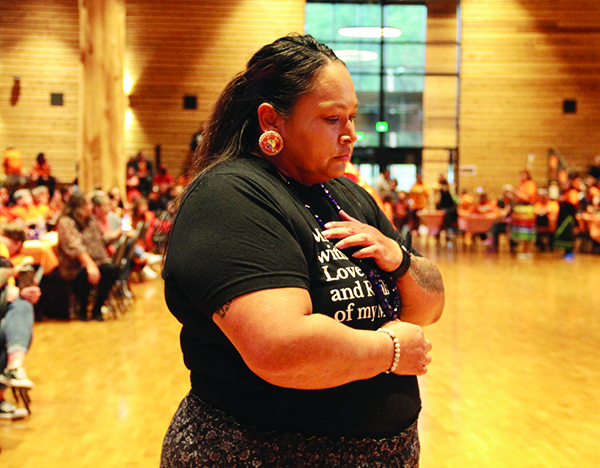
The emotional and heartfelt event was full of song and prayer to instigate healing and spiritual restoration. Tribal and community members wore orange to symbolize the day and show unity in efforts to raise awareness about these issues. And the phrase “Every Child Matters” was seen printed on items like earrings, t-shirts, and bags to remind those around us of the horrific acts that our families and ancestors once endured.
Throughout history our people have been silenced, demonized, and violated. Residential Boarding Schools are just another example of this horrific past and the grounds in which this country was built. The National Native American Boarding School Healing Coalition has identified more than 350 boarding schools that were operated by the US Federal government and the churches, from 1869 to the 1960s. Their philosophy being, “Kill the Indian, save the man.”
Native American children were forcibly taken from their homes and placed into these boarding schools intended to implement cultural genocide. Native children suffered various amounts of emotional, physical, sexual, mental and spiritual abuse. And in many cases, death. Children were no longer allowed to speak their native language, wear their traditional clothing, sing or dance, and partake in any of their cultural practices.
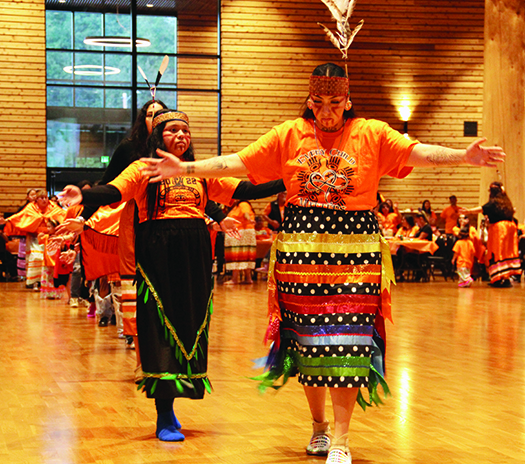
The US Interior Department has so far recognized 53 boarding school burial sites, both marked and unmarked. While the remains of our ancestors continually are found, the Interior Department acknowledged that these numbers will continue to grow as research continues. Today, 75 of the remaining boarding schools are still open, and 15 of them are still boarding.
This heartbreak is nothing new to our people, it is something that Indigenous people across the continent continue to feel and strive to overcome. Native Americans continue to fight and spread the word on this horrific era, and make the tragedies of our people known.
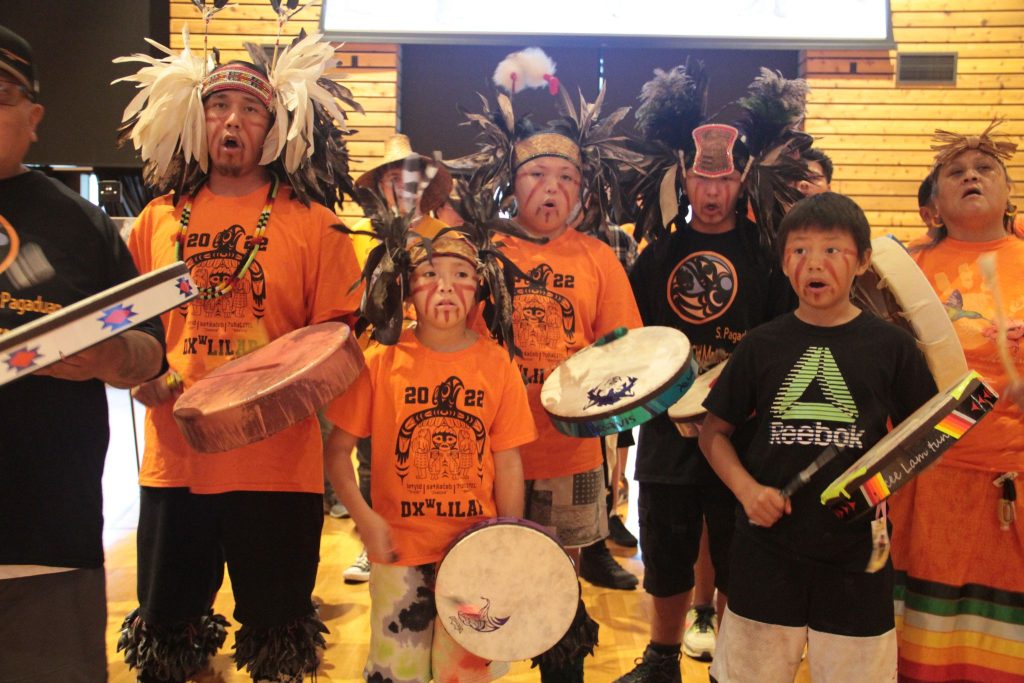
When speaking about the intentions behind Residential Boarding School Awareness Day, Youth and Family Enrichment Manager Josh Fryberg said “We come together to raise awareness about boarding schools, and to bring our people healing in the best way that we know how.”
For our people to be able to gather like we once did, to sing and dance, and honor our ancestors, it speaks to the level of perseverance that our people have and will continue to portray.
Audrina Bumgarner elevates Orange Shirt Day at her school
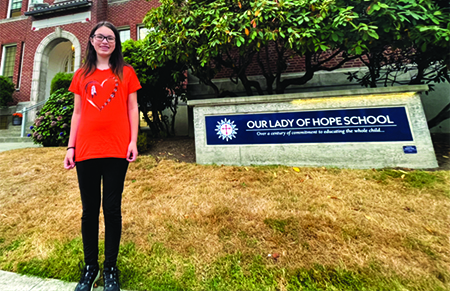
By Micheal Rios, Tulalip News
Youth-led. A common catch-all term used to describe events, efforts, or movements where youth are the face and first point of contact. However, it’s become rarer and rarer for such a thing to actually be true. More often than not, its adults pulling the strings from the background and projecting their virtues onto youth who are unable to describe the enormity of such grandiose concepts that their string bearers have bestowed upon them.
That isn’t to say youth-led efforts, in the truest sense of the term, don’t happen. Because they do. And when they occur they are usually noteworthy stories full of inspiration. Such is the case with 13-year-old Audrina Bumgarner and her commitment to seeing her school, Our Lady of Hope, recognize the National Day for Truth and Reconciliation.
More commonly known as Orange Shirt Day, September 30th has propelled itself into the mainstream because of Indigenous efforts all across North America. As Indigenous lore tells it, the day was created by Phyllis Webstad (Canadian First Nation) who tells the powerful story of having her orange shirt taken away when she attended a residential school, as well as being stripped of her language, culture and childhood joy.
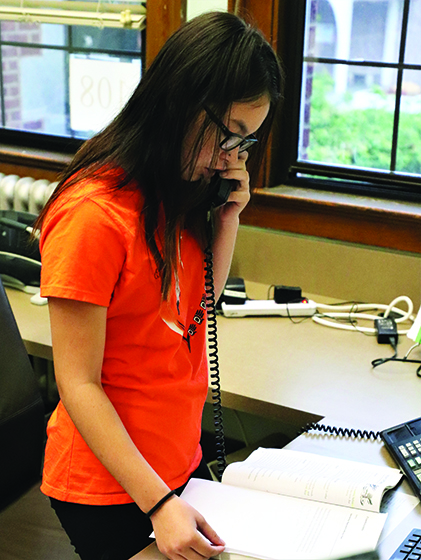
“I went to the Mission for one school year in 1973-1974. I had just turned 6-years-old,” explained Phyllis. “I lived with my grandmother on the Dog Creek reserve. We never had very much money, but somehow my granny managed to buy me a new outfit to go to the Mission school. I remember going to the store and picking out a shiny orange shirt. It was so bright and exciting…just like I felt to be going to school.
“When I got to the Mission, they stripped me and took away my clothes, including the orange shirt. I never wore it again. [Since then] the color orange has always reminded me that my feelings didn’t matter, how no one cared and how I felt like I worthless. All of us little children were crying and no one cared.”
Phyllis’s words put literal truth to power as National Day for Truth and Reconciliation has since been adopted by both Canadian and U.S. governments to support the stories and memories of the children and generations lost during the Boarding School Era.
With this powerful sentiment in mind, young Tulalip citizen Audrina approached her catholic school’s leadership staff several weeks ago with a simple request: formally recognize Orange Shirt Day by allowing the school’s Tulalip students and their fellow student allies to be exempted from the school’s uniform dress code in order to proudly wear orange. After consideration, the school honored the request.
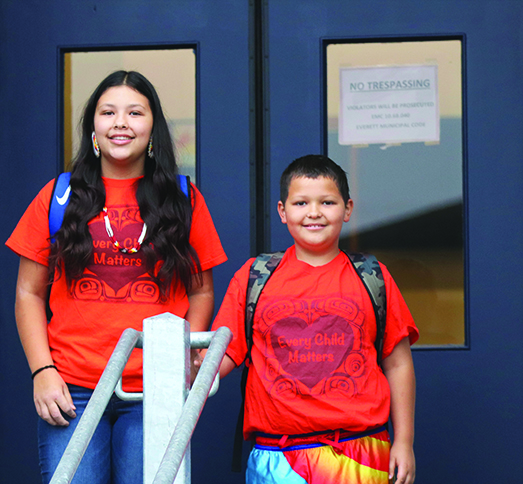
“Our student council has been focused on several projects this year. One of those projects was created by Audrina who wanted us to recognize Orange Shirt Day in a bigger way than we have ever done in the past,” said Our Lady of Hope principal Kathy Wartelle. “She came with a complete plan that felt empowering to her and her community, while also being beneficial to teaching others about the day’s significance.
“It’s incredibly important that we, as a school, support our students of multicultural backgrounds,” she added. “We love the diversity that our school has and have develop a great relationship with the Tulalip Tribes. We have close to 50 Tulalip students attending this year, so it’s important that we continue to learn from one another and our families. This means recognizing the impacts of past discretions have had on all cultures and using our faith to lift each other up.”
With the support of Our Lady of Hope’s leadership, Audrina elevated Orange Shirt Day to new heights and led her fellow Tulalip peers in proudly wearing their culture on their impossible to miss, bright orange shirts. For students who wanted to support the movement but didn’t own an orange shirt, the administrative staff hand crafted orange ribbons that could be pinned to the students’ uniform.
As students took to their seats in preparation of the school day, Audrina took to the school-wide microphone with a heartfelt message intended to educate those within the private catholic school who may have been unaware of day’s significance.
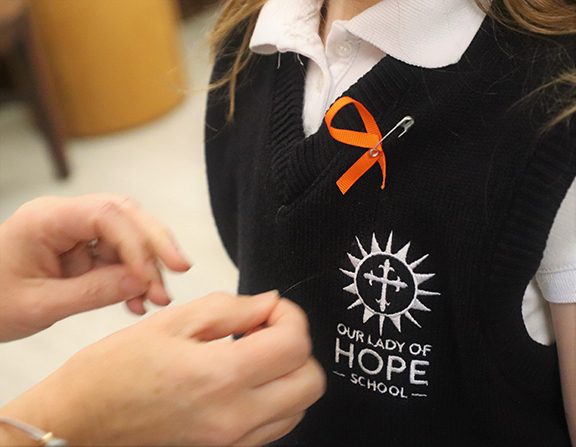
“Orange Shirt Day is in recognition of the lasting trauma these Indian Residential Schools caused to survivors and their families and Native Americans to this day. This is a day for healing and to remember the children who didn’t come home. On this day we pray for healing,” declared the inspirational Tulalip youth.
While her words resounded throughout the classrooms and hallways of the Everett-based school, her well-intentional effort came to fruition in the hearts and minds of her peers and teachers who not only took in her message, but also weren’t afraid to showcase their support by wearing orange.
“Last year, only me and a handful of other students wore orange. The awareness wasn’t really there, so I wanted to make it more recognized and bring more awareness to the day this year,” explained the 13-year-old while. “Orange Shirt Day is a day of remembrance to honor the children who didn’t come home and also the children who did come home because the survivors and their families are still affected to this day.”
Following Audrina’s school-wide announcement, Dion Joseph, father of Our Lady of Hope students Gia and Kingston Joseph who rocked their Every Child Matters orange swag to school, summed up the day’s youth-led development perfectly. “It means a lot because not only are our kids honoring their ancestors by going to school to get an education, but they also are educating and bringing awareness to others about the true history of our people and the true history of European people. It makes me proud to know those truths are no longer being swept under the rug.”
QCT holds moving tribute in recognition of Orange Shirt Day
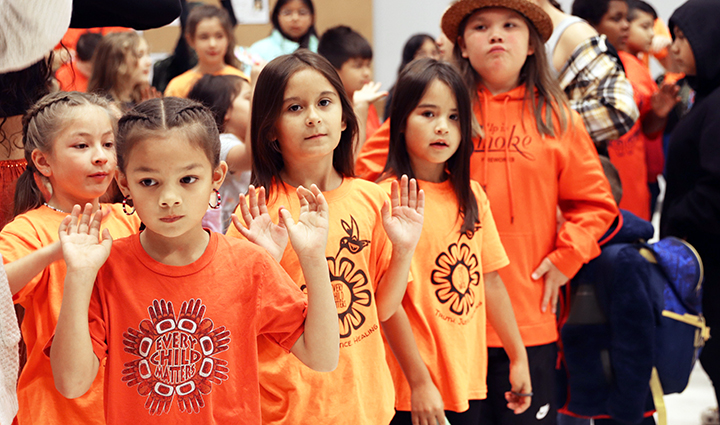
By Kalvin Valdillez, Tulalip News
The color orange was the prominent hue on the morning of September 30th at Quil Ceda Tulalip Elementary (QCT). The color was visible everywhere you looked around the school’s gym during their morning assembly, as students and teachers alike proudly showcased their orange t-shirts, hoodies, and traditional regalia. The majority of the orange clothing displayed Salish formline designs accompanied with the message, ‘Every Child Matters’, the official slogan of Residential Boarding School Awareness Day, also known as National Day for Truth and Reconciliation.
“How many of you are learning a little bit about orange shirt day?” asked Tulalip Youth Advocate, Deyamonta Diaz once the kids were situated, and he had their full attention. Dozens of hands raised in the air in reply to his question. “Wow! Okay, that’s a lot of you,” he replied with a grin of astonishment.
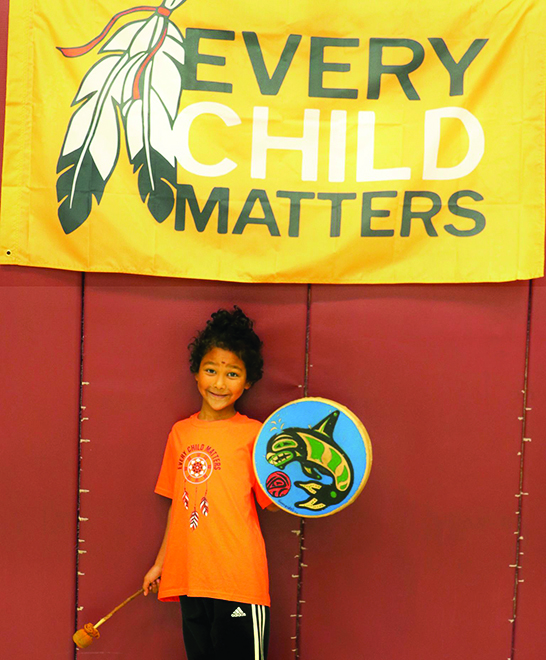
He continued, “The intent of orange shirt day, for us as Tulalip people, is to give remembrance and honor to boarding school survivors and also the children who were lost in the boarding schools throughout history. We have the Tulalip boarding school historical site, that is now the Tulalip dining hall. Today, we give remembrance to our ancestors, the people who went through the boarding school. That’s why today we wear our orange shirts, to give truth and to shine a light on those things that have happened in history. I’m happy that you are all learning about boarding schools, and specifically what happened here at Tulalip.”
In 2021, the Marysville School District released a proclamation officially declaring September 30th as Orange Shirt Day, bringing attention to the lives lost and trauma gained from the early 1900’s Indian boarding schools. Children between the ages 5 and 18 were forcibly removed from their families and traditions to attend these horrific boarding schools during the assimilation era.
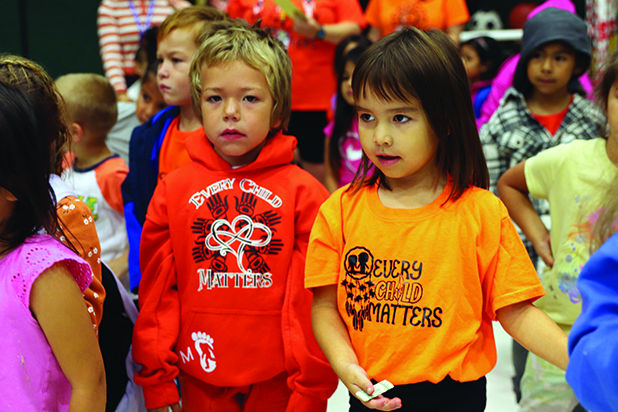
After last year’s proclamation, schools across the entire district participated in the awareness day by teaching their students about residential boarding schools and encouraging everybody to wear orange. Located on the Tulalip Reservation, QCT is mindful about the traditions of the sduhubš people and incorporated the culture into both the curriculum and everyday activities, such as the morning assembly. Students at QCT acquire first-hand knowledge about the tribe’s lifeways through collaboration with Tulalip’s membership, and they learn phrases and words from the Lushootseed language as well as several Tulalip songs, dances, and stories each year.
“It’s an honor to serve the Tulalip people every day,” said QCT Assistant Principal, Yolanda Gallegos. “One thing we [QCT principals] think about as a leader is how do we create spaces to make sure we’re not making decisions about Tulalip people and the education of Tulalip people, and how can we do it right, as a family and staff at QCT, to listen, support, and serve our community. That’s one way of reconciliation, instead of just saying sorry – it’s what are the actions and what are we doing to make sure we’re creating spaces to get out of the way and repair the harm that has happened to our people through boarding schools. This is a part of that, and a good example of our healing.”
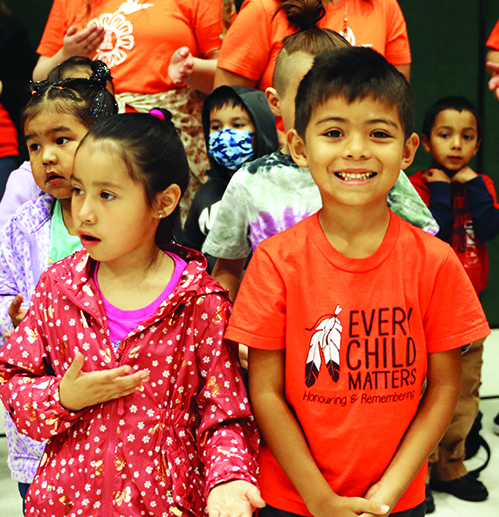
The children were asked to remain seated and quiet while the Tulalip Youth Advocates, a select few QCT student drummers, and Heritage High School student drummers, offered a song in remembrance and recognition of all the kids who experienced the trauma of the Indian boarding school era, and those children who never made it home.
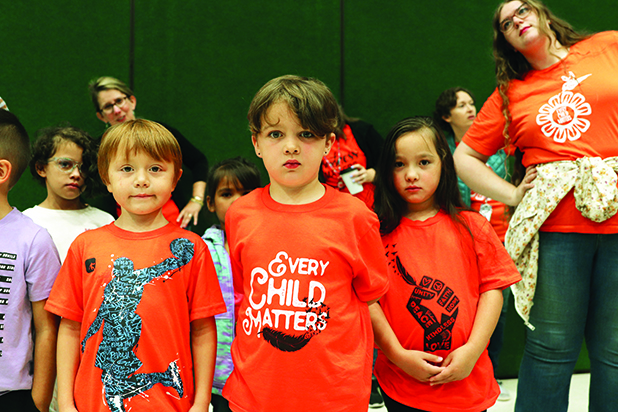
Though a large portion of the song is in the Lummi ancestorial language, a few of the lyrics are sung in English during the bridge of the song:
When they came, they took you from us. No remorse. Stripped away, never see you again.
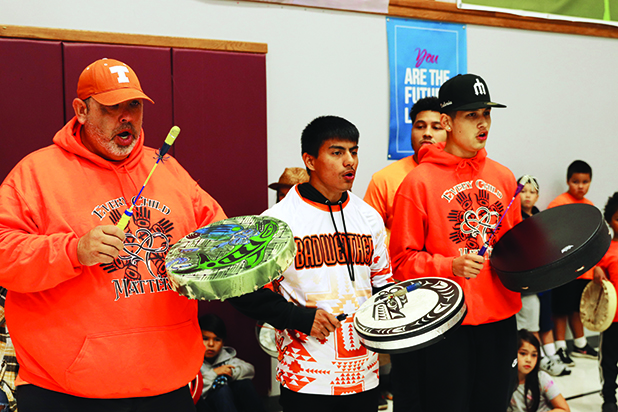
Tulalip Youth Advocate and cultural bearer, Tony Hatch, shared the origin and meaning behind the song, “That song was composed by our relative Antone George, from Lummi and the West Shore Canoe Family, to recognize Orange Shirt Day and the survivors of the boarding schools, and also the ones who passed away when attending those schools. It’s important to remember all of those children and all those things that happened. A lot of people like to think that’s ancient history, but it’s not that far back. We have a teacher at Heritage and her mother was in one of those boarding schools. That’s one generation for her. We always want to remember those things, especially since we had a boarding school right here in Tulalip. Look at all the spirit we have in this room, it’s a lot of orange shirts. Today is a very important day for us, and we thank you for wearing your orange shirts.”
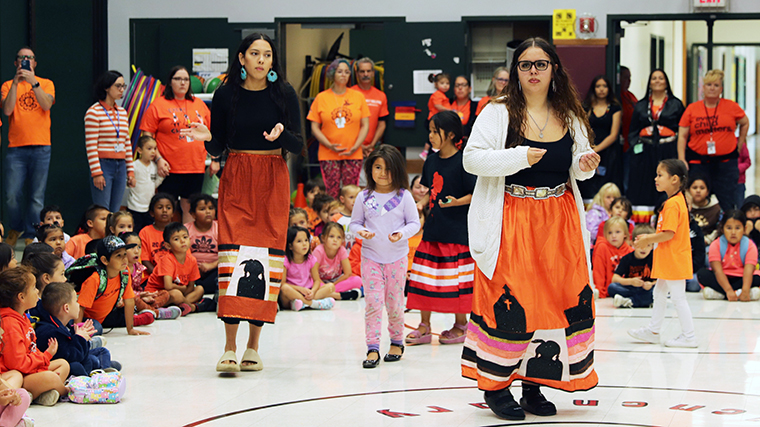
The special tribute came to end with the Happy Song, and the kids were invited to the floor to dance and sing along to the song that is well-known throughout all the coastal territories.
Senior fitness Wednesdays
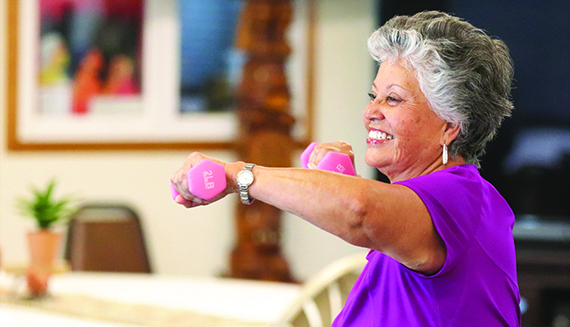
By Micheal Rios, Tulalip News
Tulalip elders Pauline Williams and Marvin Jones are regulars at the senior fitness class that takes place Wednesday mornings at 9:00 a.m. at the conveniently located Senior Center. While their commitment to a healthier heart, stronger bones, and improved flexibility should serve as positive role models to their peers, they are instead left wondering why more Tulalip seniors aren’t participating in the program.
“I’d love to see more of my beautiful Tulalip seniors attend this wonderful class,” said 78-year-old Pauline. “Movement and balance are very important for us at this stage in life. As we age, we lose the ability to do some of our favorite activities, but we can still evolve and adapt to keep our mind and body functional for other activities. For example, because of arthritis I can no longer play tennis, but I’ve adapted to the change and implemented other forms of cardio, like morning walks and dancing, into my life. These gentle workouts on Wednesday mornings are another example of adapting as we age. They are well coached and appropriately suited for us seniors.”
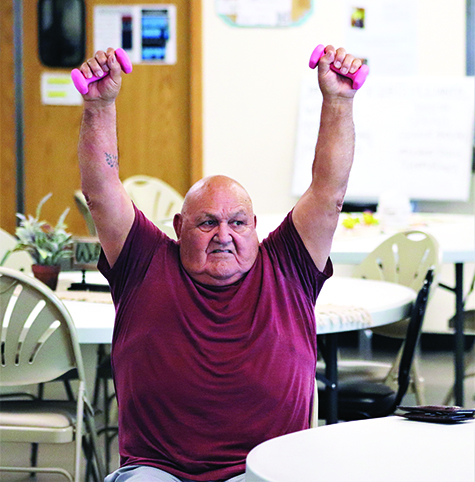
“Why do I choose to work out? Simple, to live longer,” chuckled fellow 78-year-old Marvin. “For me, these morning workouts are all about getting my joints moving and feeling better from the natural energy boosts. We have a lot of people talk about wanting to exercise, but then don’t show up when the classes are offered. It could be a lack of interest or maybe they are concerned about looking foolish. I’d tell all our seniors to come check out the class at least once to form your own opinions. We can all look foolish together.”
If you’re a senior reading this, then you’ve probably heard it time and again: physical activity and exercise are good for you, and you should commit them as part of your routine. There are countless studies that prove the important health benefits associated with exercise, and it becomes more important as we age.
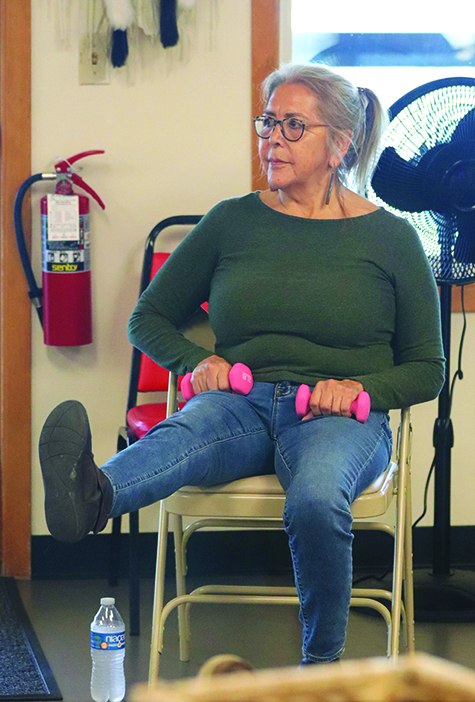
Regular physical activity and exercise for seniors helps improve mental and physical health, both of which will help you maintain your independence as you age. According to The Green Fields Continuing Care Community there are five huge benefits of exercise for seniors and aging adults:
- Prevent Disease. Studies have shown that maintaining regular physical activity can help prevent many common diseases, such as heart disease and diabetes. Exercise improves overall immune function, which is important for seniors as their immune systems are often compromised. Even light exercise, such as walking, can be a powerful tool for preventable disease management.
- Improved Mental Health. The mental health benefits of exercise are nearly endless. Exercise produces endorphins (the “feel good” hormone), which act as a stress reliever and leaves you feeling happy and satisfied. In addition, exercise has been linked to improving sleep, which is especially important for older adults who often suffer from insomnia and disrupted sleep patterns.
- Decreased Risks of Falls. Older adults are at a higher risk of falls, which can prove to be potentially disastrous for maintaining independence. Exercise improves strength and flexibility, which also help improve balance and coordination, reducing the risk of falls. Seniors take much longer to recover from falls, so anything that helps avoid them in the first place is critical.
- Social Engagement. Whether you join a walking group, go to group fitness classes or visit a gardening club, exercise can be made into a fun social event. Maintaining strong social ties is important for aging adults to feel a sense of purpose and avoid feelings of loneliness or depression. Above all, the key is to find a form of exercise you love, and it will never feel like a chore again.
- Improved Cognitive Function. Regular physical activity and fine-tuned motor skills benefit cognitive function. Countless studies suggest a lower risk of dementia for physically active individuals, regardless of when you begin a routine.
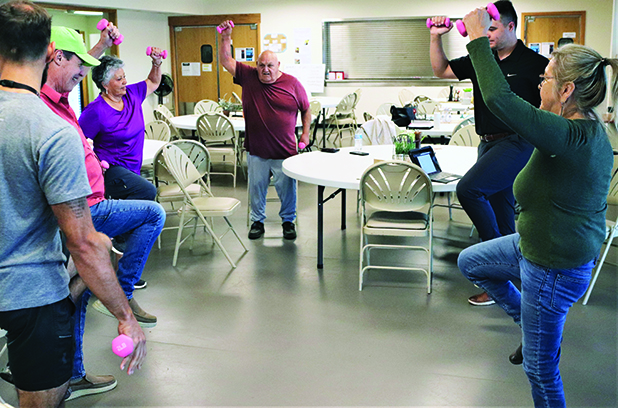
It is never too late for seniors to start engaging in a regular exercise routine. The key is to find something you enjoy doing and start at a level that is easy to maintain, which is what the senior fitness class strives to do. Led by two enthusiastic health coaches who work with Tulalip seniors routinely via the Health Clinic, Jared and David are eager to see more participation at their weekly offering.
“We try and make it these gentle workouts as adaptive as possible, so that anyone, even those with mobility issues, can participate, have some fun and get a possible health outcome from the class,” said physical therapist, Dr. David Morris. “Hopefully, we start to accumulate more people joining and being a part of this health movement. No signups or reservations needed. Just come on down. Wednesdays at 9:30 a.m. at the Senior Center. Bring your brother and sisters, cousins, and significant others with you.”
For those seeking more information or have questions about the senior fitness Wednesdays, please call Dr. Morris at 360-716-4511.
October 1, 2022 syəcəb
Please use the following link to download the October 1, 2022 issue of the syəcəb
ATNI experiences a night of Tulalip culture
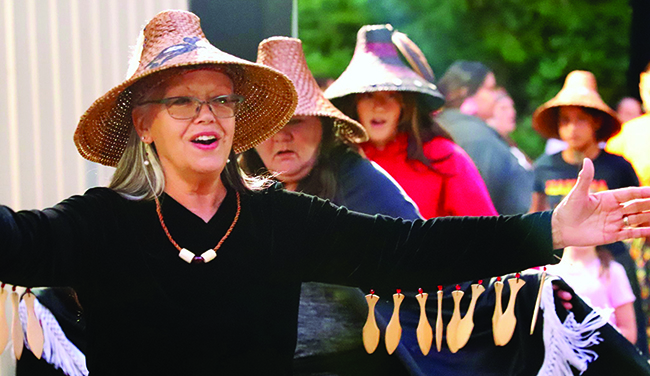
By Kalvin Valdillez, Tulalip News
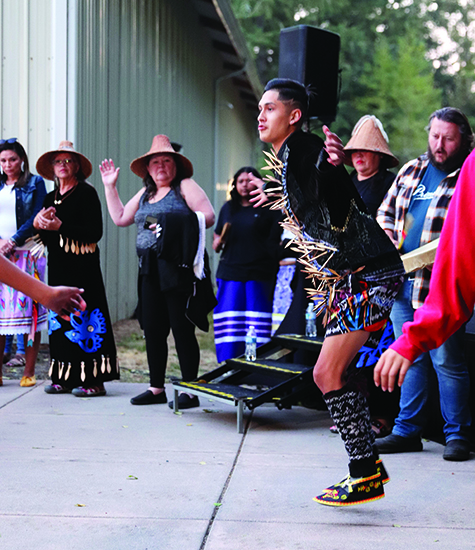
During the week of September 19, ATNI held their annual conference at the Tulalip Resort Casino. Following the second day of presentations and workshops, dozens of Northwest tribal leaders visited the Hibulb Cultural Center to learn about the Tulalip way of life.
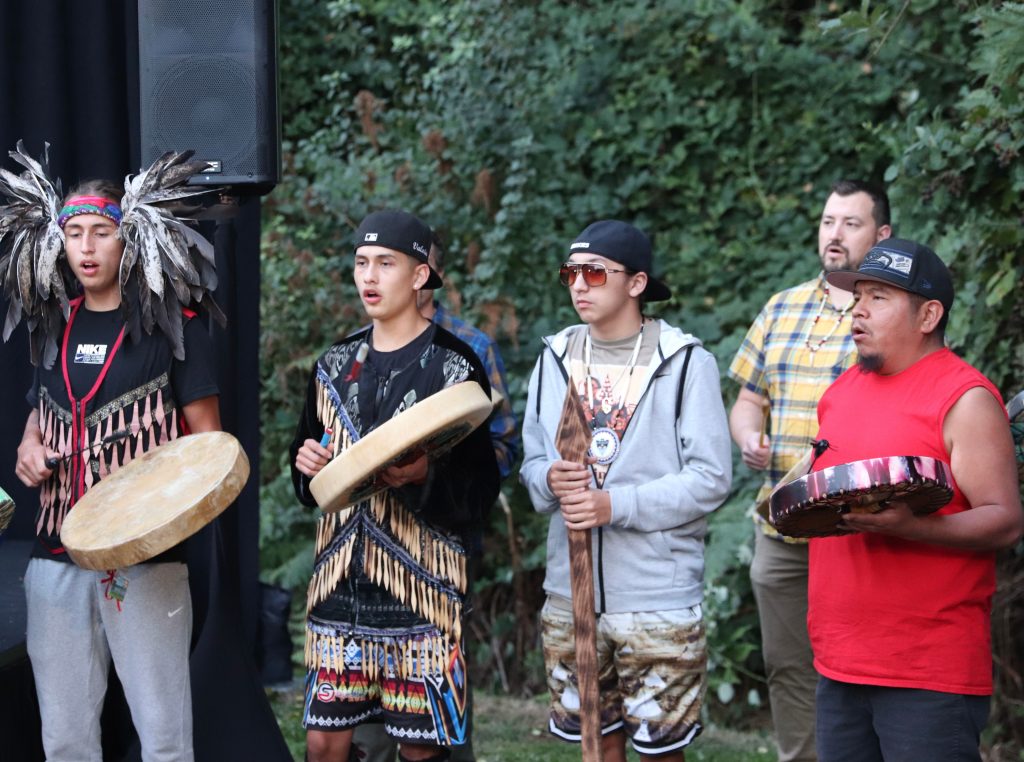
The guests were treated to a delicious salmon bake dinner and a glimpse into the culture of the sduhubš people, complete with traditional songs and dances. The ATNI leaders also had the chance to tour the entire cultural museum to end the evening.
